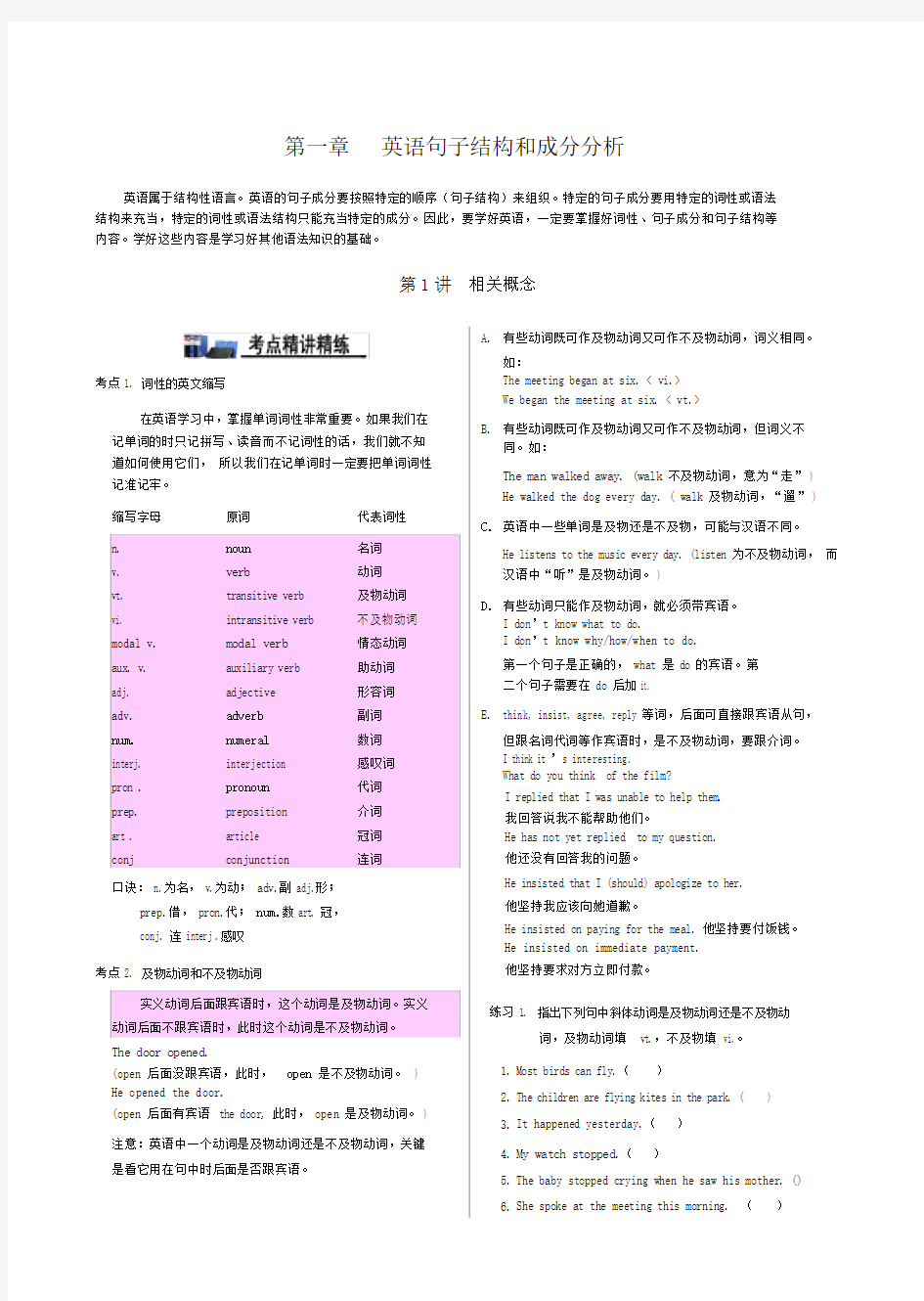

第一章英语句子结构和成分分析
英语属于结构性语言。英语的句子成分要按照特定的顺序(句子结构)来组织。特定的句子成分要用特定的词性或语法结构来充当,特定的词性或语法结构只能充当特定的成分。因此,要学好英语,一定要掌握好词性、句子成分和句子结构等内容。学好这些内容是学习好其他语法知识的基础。
第1讲相关概念
考点 1.词性的英文缩写
在英语学习中,掌握单词词性非常重要。如果我们在记单词的时只记拼写、读音而不记词性的话,我们就不知道如何使用它们,所以我们在记单词时一定要把单词词性记准记牢。
缩写字母原词代表词性
n.noun名词
v.verb动词
vt.transitive verb及物动词
vi.intransitive verb不及物动词modal v.modal verb情态动词
aux. v.auxiliary verb助动词
adj.adjective形容词
adv.adverb副词
num.numeral数词
interj.interjection感叹词
pron .pronoun代词
prep.preposition介词
art .article冠词
conj conjunction连词
口诀: n.为名, v.为动; adv.副 adj.形;
prep.借, pron.代; num.数 art. 冠,
conj. 连 interj .感叹
考点 2.及物动词和不及物动词
实义动词后面跟宾语时,这个动词是及物动词。实义动词后面不跟宾语时,此时这个动词是不及物动词。
The door opened.
(open 后面没跟宾语,此时,open 是不及物动词。) He opened the door.
(open 后面有宾语the door, 此时, open 是及物动词。 )注意:英语中一个动词是及物动词还是不及物动词,关键是看它用在句中时后面是否跟宾语。A.有些动词既可作及物动词又可作不及物动词,词义相同。
如:
The meeting began at six. < vi.>
We began the meeting at six. < vt.>
B.有些动词既可作及物动词又可作不及物动词,但词义不
同。如:
The man walked away. (walk 不及物动词,意为“走” )
He walked the dog every day. ( walk 及物动词,“遛” ) C.英语中一些单词是及物还是不及物,可能与汉语不同。
He listens to the music every day. (listen 为不及物动词,而汉语中“听”是及物动词。 )
D.有些动词只能作及物动词,就必须带宾语。
I don’t know what to do.
I don’t know why/how/when to do.
第一个句子是正确的, what 是 do 的宾语。第
二个句子需要在 do 后加 it.
E.think, insist, agree, reply 等词,后面可直接跟宾语从句,
但跟名词代词等作宾语时,是不及物动词,要跟介词。
I think it ’s interesting.
What do you think of the film?
I replied that I was unable to help them.
我回答说我不能帮助他们。
He has not yet replied to my question.
他还没有回答我的问题。
He insisted that I (should) apologize to her.
他坚持我应该向她道歉。
He insisted on paying for the meal. 他坚持要付饭钱。
He insisted on immediate payment.
他坚持要求对方立即付款。
练习 1.指出下列句中斜体动词是及物动词还是不及物动
词,及物动词填vt.,不及物填 vi.。
1.Most birds can fly.()
2.The children are flying kites in the park. ()
3.It happened yesterday.()
4.My watch stopped.()
5.The baby stopped crying when he saw his mother. ()
6.She spoke at the meeting this morning. ()
7.Shall I begin at once?()
8.She began working as a teacher after she left school.()
()
9.When did they leave Beijing? ()
10.They left last week.()
练习 2.改错:
1.He never dreamed of that one day he would become
President.
2.What do you think the plan ?
3.He never replied any of my letters.
4.He insisted staying up to nurse the patient.
5.He entered into the classroom quietly.
6.He will marry with her next month.
考点 3.实义动词、助动词与情态动词
实义动词和助动词是根据动词在句子中的含义和作用来划分的。实义动词也叫行为动词。
实义动词
指的是那些意义完全且能够独立作谓语的动词。如:
He lives quite near. (live“住”,有明确的意义,单独作谓
语,为实义动词。)
I like reading. ( like “喜欢”,意思明确,单独作谓语,
为实义动词。)
I bought a pen yesterday. ( bought “买”,意义明确,单
独作谓语,为实义动词。)
助动词
助动词的“助”是“帮助”之意。因此,助动词是指那些用来帮助构成时态、语态、虚拟语气、疑问句、否定
句、倒装句和帮助强调的词。这些词本身无词汇意义或意
义不完全,不能单独作谓语。
A.帮助构成时态的:
The boy is crying. (is 用来帮助构成现在进行时,和 crying 一起作谓语,是助动词。)
He has arrived. (has 用来帮助构成现在完成时,和arrived 一起作谓语,是助动词。)
I have been painting all day. ( have been用来帮助构成现在
完成进行时,和 painting 一起作谓语,都是助动词。)
B.帮助构成否定句和疑问句的:
Does he like English? (does 帮助构成一般疑问句,没有具
体意义,是助动词。 )
He doesn’ t have lunch at home. (does 只是帮助构成否定
句,没有具体意义,是助动词。 ) C.帮助构成被动语态的
Trees are planted in spring. (are 帮助构成被动语态,没有
具体意义,是助动词。 )
The house has been pulled down. (has been 帮助构成时态和语态,是助动词。 )
D.帮助构成虚拟语气
If he had come yesterday, Iwould n’havet made such a
mistake.(had, have 帮助构成虚拟语气,是助动词,属于谓语的一部分。 )
E.帮助构成倒装句的
So much did he love his mother that he bought her many
presents on her birthday.
( 他如此爱他的母亲以至于他母亲生日那一天,他给她买
了许多礼物。 did 只是帮助构成倒装句,没有具体意义,
是助动词。 )
F.帮助构成强调意义的
He did come yesterday. (他昨天确实来过。 did 起强调作
用,没有具体意义,是助动词。 )
因此可以看出,常见的助动词为do, be, have,它们
为基本助动词。一个词既可以作实义动词也可以作助动
词,具体是哪一种,主要看它们在句中的功能。
①He did his homework at seven o(did’单独clock作谓.语,
意为“做”,是实义动词。)
Did he do his homework yesterday? (did 是助动词,帮助
构成一般疑问句, do 是实义动词,意为“做” ,是实义
动词。 )
②He has had breakfast. (has 是助动词,帮助构成现在完成
时,had 是实义动词,意为“吃”。has had一起构成
了句子的谓语。 )
练习 3.指出下列斜体单词是实义动词还是助动词。
1.Does () he like () swimming?
2.He does () like ( ) swimming.
3.Where does( ) he live ( )?
4.He does () some washing after work.
5.He has () had () supper already.
6.The bridge has() been( ) built ( ) now.
7.I have () been ()waiting ( ) for you all day.
8.He was () struck ( ) by a stone.
情态动词
情态动词同助动词一样,不能单独作谓语,要和实义动词一起作谓语。因此,情态动词也称为情态助动词。情
态动词同基本助动词的区别在于,基本助动词本身无意义,而情态动词有自己的意义。如:
He can swim across the river. (can 的词义为“能够”)I might leave tomorrow. ( might 的词义为“或许” )You must stay at home. (must 词义为“必须”)
第2讲句子成分
英语的句子成分主要有六种:即主语、谓语、宾语、定语、状语和补语。(可以熟记为:主谓宾,定状补)除
了这六种主要成分之外,还有“表语”和“同位语”的说
法。但表语和系动词一起作谓语,因此划分成分时,划分
在谓语上。同位语分为主语同位语和宾语同位语,属于主
语或宾语的一部分。
考点 4.划分句子成分时的常用符号
英语中划分句子成分的符号
主语在下面画直线
谓语在下面画曲线
宾语在下面画双横线
定语在下面画虚线(一行点使我们想到一排钉子,
“钉”谐音为“定语”的“定”)
状语下面为短横线(短横线使我们想到短木桩,木桩撞(状)钟)
补语上一短横,下一短横(下一短横好像是为了弥
补上面短横间的空隙)
同位语上下双曲线(都有曲折,上下位置基本相同)
考点 1.主语
主语是一个句子所叙述的主体,一般位于句首,通常由名词性的词来充当。
可以作主语的词性或语法结构:
1.名词
2.代词
3.数词
4.不定式
5.动名词
6.主语从句等表示。
7.名词化的形容词(如 the rich )
在英语中,形容词、副词和介词短语是不能作主语的。
如果它们在句首时,句子可能是倒装句,真正的主语在后面。On the desk are some books . ( 主语是 books,所以用 are) Down jumps the boy . ( 主语是 the boy,所以用 jumps ) Gone are the days . ( 主语是 the days,所以用 are)
练习 1.在下面句子的主语下面画横线,并说出由什么充当。
1.During the 1990s, American country music has become
more and more popular.
2.We often speak English in class.
3.One-third of the students in this class are girls.
4.To swim in the river is a great pleasure.
5.Smoking does harm to the health.
6.The rich should help the poor.
7.When we are going to have English test has not been
decided.
8.It is necessary to master a foreign language.
9.That he isn ’ t at home is not. true
10.There comes the bus.
11.Beyond the village lies a small village.
12.Now comes your turn.
考点 2.谓语
谓语由动词充当,说明主语所做的动作或具有的特征和状态。谓语的构成如下:
A.简单谓语:由一个动词或动词短语构成。如:
He practices running every morning.
He reads newspapers every day.
B.复合谓语:
①由情态动词或其他助动词加动词构成。如:
You may keep the book for two weeks.
He has caught a bad cold.
My sister is crying over there.
I have been waiting for you all the time.
I would stay at home all day.
Has he come back?
He did n’tattend the meeting yesterday.
② 由系动词加表语构成。系动词不能单独作谓语,要和
表语一起作谓语。如:
We are student s.
Your idea sounds great.
考点 3.表语
表语多是形容词,用以说明主语的身份、特征和状态,它一般位于系动词(如be, become, get, look, grow, turn, seem等)之后。表语一般由名词、代词、形容词、分词、
数词、不定式、动名词、介词短语、副词及表语从句表示。
练习 2. 画出下列句中的表语,并说明由什么充当。
1.Our teacher of English is an American.
2.Is it yours?
3.The weather has turned cold.
4.The speech is exciting.